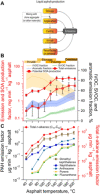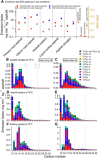Asphalt-related emissions are a major missing nontraditional source of secondary organic aerosol precursors
- PMID: 32917599
- PMCID: PMC7467703
- DOI: 10.1126/sciadv.abb9785
Asphalt-related emissions are a major missing nontraditional source of secondary organic aerosol precursors
Abstract
Asphalt-based materials are abundant and a major nontraditional source of reactive organic compounds in urban areas, but their emissions are essentially absent from inventories. At typical temperature and solar conditions simulating different life cycle stages (i.e., storage, paving, and use), common road and roofing asphalts produced complex mixtures of organic compounds, including hazardous pollutants. Chemically speciated emission factors using high-resolution mass spectrometry reveal considerable oxygen and reduced sulfur content and the predominance of aromatic (~30%) and intermediate/semivolatile organic compounds (~85%), which together produce high overall secondary organic aerosol (SOA) yields. Emissions rose markedly with moderate solar exposure (e.g., 300% for road asphalt) with greater SOA yields and sustained SOA production. On urban scales, annual estimates of asphalt-related SOA precursor emissions exceed those from motor vehicles and substantially increase existing estimates from noncombustion sources. Yet, their emissions and impacts will be concentrated during the hottest, sunniest periods with greater photochemical activity and SOA production.
Copyright © 2020 The Authors, some rights reserved; exclusive licensee American Association for the Advancement of Science. No claim to original U.S. Government Works. Distributed under a Creative Commons Attribution NonCommercial License 4.0 (CC BY-NC).
Figures





References
-
- Khare P., Gentner D. R., Considering the future of anthropogenic gas-phase organic compound emissions and the increasing influence of non-combustion sources on urban air quality. Atmos. Chem. Phys. 18, 5391–5413 (2018).
-
- Mcdonald B. C., de Gouw J. A., Gilman J. B., Jathar S. H., Akherati A., Cappa C. D., Jimenez J. L., Lee-Taylor J., Hayes P. L., McKeen S. A., Cui Y. Y., Kim S.-W., Gentner D. R., Isaacman-VanWertz G., Goldstein A. H., Harley R. A., Frost G. J., Roberts J. M., Ryerson T. B., Trainer M., Volatile chemical products emerging as largest petrochemical source of urban organic emissions. Science 359, 760–764 (2018). - PubMed
-
- Jimenez J. L., Canagaratna M. R., Donahue N. M., Prevot A. S. H., Zhang Q., Kroll J. H., De Carlo P. F., Allan J. D., Coe H., Ng N. L., Aiken A. C., Docherty K. S., Ulbrich I. M., Grieshop A. P., Robinson A. L., Duplissy J., Smith J. D., Wilson K. R., Lanz V. A., Hueglin C., Sun Y. L., Tian J., Laaksonen A., Raatikainen T., Rautiainen J., Vaattovaara P., Ehn M., Kulmala M., Tomlinson J. M., Collins D. R., Cubison M. J., Dunlea E. J., Huffman J. A., Onasch T. B., Alfarra M. R., Williams P. I., Bower K., Kondo Y., Schneider J., Drewnick F., Borrmann S., Weimer S., Demerjian K., Salcedo D., Cottrell L., Griffin R., Takami A., Miyoshi T., Hatakeyama S., Shimono A., Sun J. Y., Zhang Y. M., Dzepina K., Kimmel J. R., Sueper D., Jayne J. T., Herndon S. C., Trimborn A. M., Williams L. R., Wood E. C., Middlebrook A. M., Kolb C. E., Baltensperger U., Worsnop D. R., Evolution of organic aerosols in the atmosphere. Science 326, 1525–1529 (2009). - PubMed
-
- Ma P. K., Zhao Y., Robinson A. L., Worton D. R., Goldstein A. H., Ortega A. M., Jimenez J. L., Zotter P., Prévôt A. S. H., Szidat S., Hayes P. L., Evaluating the impact of new observational constraints on P-S/IVOC emissions, multi-generation oxidation, and chamber wall losses on SOA modeling for Los Angeles, CA. Atmos. Chem. Phys. 17, 9237–9259 (2017).
-
- Zhao Y., Hennigan C. J., May A. A., Tkacik D. S., de Gouw J. A., Gilman J. B., Kuster W. C., Borbon A., Robinson A. L., Intermediate-volatility organic compounds: A large source of secondary organic aerosol. Environ. Sci. Technol. 48, 13743–13750 (2014). - PubMed
LinkOut - more resources
Full Text Sources
Other Literature Sources

